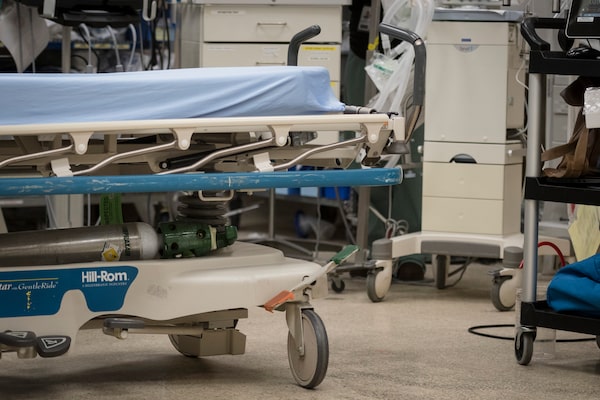
The trauma bay at St. Michael's Hospital in Toronto in August, 2019. A report from the Canadian Institute for Health Information estimated that nearly 938,000 fewer surgeries were performed across Canada during the first 2½ years of the pandemic, compared with prepandemic volumes.Tijana Martin/The Canadian Press
Patients have continued to wait longer for certain surgeries, particularly knee and hip replacements, than they did in 2019, according to a new report from the Canadian Institute for Health Information.
The report, released Thursday, estimated that nearly 938,000 fewer surgeries were performed across Canada during the first 2½ years of the pandemic, compared with prepandemic volumes.
“In order to decrease waits across the country, we really are going to have to increase those surgeries to prepandemic levels and beyond if we hope to keep up,” said Tracy Johnson, director of health system analytics at CIHI.
The report found about 20 per cent fewer knee replacements, 11 per cent fewer hip replacements and 10 per cent fewer cataract surgeries were done on patients, ages 18 and older, between April, 2020, and September, 2022, than before the pandemic. It calculated these estimates by comparing surgical data for each month during the pandemic against data for the same month in 2019.
The numbers of scheduled and non-urgent surgeries plunged sharply during the first COVID-19 wave, and dipped again during subsequent waves as many were postponed or rescheduled. But even as hospitals have tried to catch up between waves, the report said surgical volumes rarely surpassed prepandemic levels.
Between April and September, 2022, after the large initial Omicron wave, waiting times for several types of surgery were longer than they were before the pandemic, the report found. Around 50 per cent of knee replacements and 57 per cent of hip replacements were done within the recommended six months between the time a surgeon determines a surgery is needed and when the patient receives it. By comparison, before the pandemic, 70 per cent of knee replacements and 75 per cent of hip replacements were done within the recommended benchmark timeframe.
Although there were variations between provinces, national waiting times for cataract surgeries have bounced back to roughly prepandemic levels. Catching up on these surgeries has been less challenging since they can be done in day-surgery or community clinics, the report said. About 66 per cent of cataract surgeries were done between April and September, 2022, within the recommended 112 days, compared with 70 per cent during the same period in 2019.
The report found that even though urgent surgeries, such as those for cancer, were prioritized throughout the pandemic, and thus were less affected by delays, waiting times for cancer surgeries edged higher in 2022. Compared with before the pandemic, the median waiting time increased by 12 days for prostate cancer surgery, and by one to three days for breast, bladder, colorectal and lung surgeries.
These waiting times do not include the time between when patients first experience symptoms and when they see a doctor, nor the wait for a referral, testing or diagnosis. As The Globe previously reported, in September, 2022, only 20 per cent of B.C. patients referred to an oncologist were seen within two weeks.
Ms. Johnson said CIHI had been recording improvements in surgical waiting times across the country about a decade ago, when more than 80 per cent of patients in many provinces were getting most surgeries within the recommended benchmark timeframes, she said. Just before the pandemic, however, that had declined to about 70 to 75 per cent.
Part of the reason waiting times have gotten longer in 2022 is because surgical volumes have not yet returned to prepandemic levels, she said. But a shortage of health professionals, which has only worsened since the start of the pandemic, has contributed to the problem.
As large numbers of health care workers have retired or left their jobs, staffing operating rooms and finding enough people to support patients has been difficult, she said. “We don’t have enough doctors and nurses.”
 Wency Leung
Wency Leung